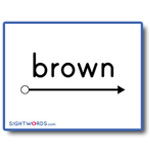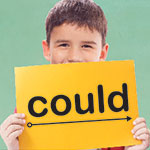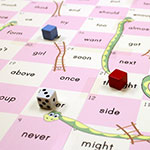When you’re a new teacher, the number of buzzwords that you have to master seems overwhelming at times. You’ve probably heard about many concepts, but you may not be entirely sure what they are or how to use them in your classroom. For example, new teacher Katy B. asks, “This seems like a really basic question, but what are sight words, and where do I find them?” No worries, Katy. We have you covered!
What’s the difference between sight words and high-frequency words?
Oftentimes we use the terms sight words and high-frequency words interchangeably. Opinions differ, but our research shows that there is a difference. High-frequency words are words that are most commonly found in written language. Although some fit standard phonetic patterns, some do not. Sight words are a subset of high-frequency words that do not fit standard phonetic patterns and are therefore not easily decoded.
We use both types of words consistently in spoken and written language, and they also appear in books, including textbooks, and stories. Once students learn to quickly recognize these words, reading comes more easily.
What are sight words and how can I teach my students to memorize them?
Sight words are words like come, does, or who that do not follow the rules of spelling or the six types of syllables. Decoding these words can be very difficult for young learners. The common practice has been to teach students to memorize these words as a whole, by sight, so that they can recognize them immediately (within three seconds) and read them without having to use decoding skills.
Can I teach sight words using the science of reading?
On the other hand, recent findings based on the science of reading suggests we can use strategies beyond rote memorization. According to the the science of reading, it is possible to sound out many sight words because they have recognizable patterns. Literacy specialist Susan Jones, a proponent of using the science of reading to teach sight words, recommends a method called phoneme-grapheme mapping where students first map out the sounds they hear in a word and then add graphemes (letters) they hear for each sound.
How else can I teach sight words?
There are many fun and engaging ways to teach sight words. Dozens of books on the subject have been published, including the much-revered Comprehensive Phonics, Spelling, and Word Study Guide by Fountas & Pinnell. Also, resources like games, manipulatives, and flash cards are readily available online and in stores. To help get you started, check out these Creative and Simple Sight Word Activities for the Classroom. Also, check out Susan Jones Teaching for three science-of-reading-based ideas and more.
Where do I find sight word lists?
Two of the most popular sources are the Dolch High Frequency Words list and the Fry High Frequency Words list.
During the 1930s and 1940s, Dr. Edward Dolch developed his word list, used for pre-K through third grade, by studying the most frequently occurring words in the children’s books of that era. The list has 200 “service words” and also 95 high-frequency nouns. The Dolch word list comprises 80 percent of the words you would find in a typical children’s book and 50 percent of the words found in writing for adults.
Dr. Edward Fry developed an expanded word list for grades 1–10 in the 1950s (updated in 1980), based on the most common words that appear in reading materials used in grades 3–9. The Fry list contains the most common 1,000 words in the English language. The Fry words include 90 percent of the words found in a typical book, newspaper, or website.
Looking for more sight word activities? Check out 20 Fun Phonics Activities and Games for Early Readers.
Want more articles like this? Be sure to sign up for our newsletters.

Overview
Learn the history behind Dolch and Fry sight words, and why they are important in developing fluent readers.
More

Lessons
Follow the sight words teaching techniques. Learn research-validated and classroom-proven ways to introduce words, reinforce learning, and correct mistakes.
More

Flash Cards
Print your own sight words flash cards. Create a set of Dolch or Fry sight words flash cards, or use your own custom set of words.
More

Games
Play sight words games. Make games that create fun opportunities for repetition and reinforcement of the lessons.
More
- Overview
- What Are Sight Words?
- Types of Sight Words
- When to Start
- Scaling & Scaffolding
- Research
- Questions and Answers
1. Overview
Sight words instruction is an excellent supplement to phonics instruction. Phonics is a method for learning to read in general, while sight words instruction increases a child’s familiarity with the high frequency words he will encounter most often.
The best way to learn sight words is through lots and lots of repetition, in the form of flashcard exercises and word-focused games.
↑ Top
2. What Are Sight Words?
Sight words are words that should be memorized to help a child learn to read and write. Learning sight words allows a child to recognize these words at a glance — on sight — without needing to break the words down into their individual letters and is the way strong readers recognize most words. Knowing common, or high frequency, words by sight makes reading easier and faster, because the reader does not need to stop to try and sound out each individual word, letter by letter.
Sight Words are memorized so that a child can recognize commonly used or phonetically irregular words at a glance, without needing to go letter-by-letter.
Other terms used to describe sight words include: service words, instant words (because you should recognize them instantly), snap words (because you should know them in a snap), and high frequency words. You will also hear them referred to as Dolch words or Fry words, the two most commonly used sight words lists.
Sight words are the glue that holds sentences together.
These pages contain resources to teach sight words, including: sight words flash cards, lessons, and games. If you are new to sight words, start with the teaching strategies to get a road map for teaching the material, showing you how to sequence the lessons and activities.
↑ Top
3. Types of Sight Words
Sight words fall into two categories:
- Frequently Used Words — Words that occur commonly in the English language, such as it, can, and will. Memorizing these words makes reading much easier and smoother, because the child already recognizes most of the words and can concentrate their efforts on new words. For example, knowing just the Dolch Sight Words would enable you to read about 50% of a newspaper or 80% of a children’s book.
- Non-Phonetic Words — Words that cannot be decoded phonetically, such as buy, talk, or come. Memorizing these words with unnatural spellings and pronunciations teaches not only these words but also helps the reader recognize similar words, such as guy, walk, or some.
There are several lists of sight words that are in common use, such as Dolch, Fry, Top 150, and Core Curriculum. There is a great deal of overlap among the lists, but the Dolch sight word list is the most popular and widely used.
3.1 Dolch Sight Words
The Dolch Sight Words list is the most commonly used set of sight words. Educator Dr. Edward William Dolch developed the list in the 1930s-40s by studying the most frequently occurring words in children’s books of that era. The list contains 220 “service words” plus 95 high-frequency nouns. The Dolch sight words comprise 80% of the words you would find in a typical children’s book and 50% of the words found in writing for adults. Once a child knows the Dolch words, it makes reading much easier, because the child can then focus his or her attention on the remaining words.
More
3.2 Fry Sight Words
The Fry Sight Words list is a more modern list of words, and was extended to capture the most common 1,000 words. Dr. Edward Fry developed this expanded list in the 1950s (and updated it in 1980), based on the most common words to appear in reading materials used in Grades 3-9. Learning all 1,000 words in the Fry sight word list would equip a child to read about 90% of the words in a typical book, newspaper, or website.
More
3.3 Top 150 Written Words
The Top 150 Written Words is the newest of the word lists featured on our site, and is commonly used by people who are learning to read English as a non-native language. This list consists of the 150 words that occur most frequently in printed English, according to the Word Frequency Book. This list is recommended by Sally E. Shaywitz, M.D., Professor of Learning Development at Yale University’s School of Medicine.
More
3.4 Other Sight Words Lists
There are many newer variations, such as the Common Core sight words, that tweak the Dolch and Fry sight words lists to find the combination of words that is the most beneficial for reading development. Many teachers take existing sight word lists and customize them, adding words from their own classroom lessons.
↑ Top
4. When to Start Teaching Sight Words
Before a child starts learning sight words, it is important that he/she be able to recognize and name all the lower-case letters of the alphabet. When prompted with a letter, the child should be able to name the letter quickly and confidently. Note that, different from learning phonics, the child does not need to know the letters’ sounds.
Before starting sight words, a child needs to be able to recognize and name all the lower-case letters of the alphabet.
If a student’s knowledge of letter names is still shaky, it is important to spend time practicing this skill before jumping into sight words. Having a solid foundation in the ability to instantly recognize and name the alphabet letters will make teaching sight words easier and more meaningful for the child.
Go to our Lessons for proven strategies on how to teach and practice sight words with your child.
↑ Top
5. Scaling & Scaffolding
Every child is unique and will learn sight words at a different rate. A teacher may have a wide range of skill levels in the same classroom. Many of our sight words games can be adjusted to suit different skill levels.
Many of our activity pages feature recommendations for adjusting the game to the needs of your particular child or classroom:
- Confidence Builders suggest ways to simplify a sight words game for a struggling student.
- Extensions offer tips for a child who loves playing a particular game but needs to be challenged more.
- Variations suggest ways to change up the game a little, by tailoring it to a child’s special interests or making it “portable.”
- Small Group Adaptations offer ideas for scaling up from an individual child to a small group (2-5 children), ensuring that every child is engaged and learning.
↑ Top
6. Research
Our sight words teaching techniques are based not only on classroom experience but also on the latest in child literacy research. Here is a bibliography of some of the research supporting our approach to sight words instruction:
- Ceprano, M. A. “A review of selected research on methods of teaching sight words.” The Reading Teacher 35:3 (1981): 314-322.
- Ehri, Linnea C. “Grapheme–Phoneme Knowledge Is Essential for Learning to Read Words in English.” Word Recognition in Beginning Literacy. Mahwah, NJ: L. Erlbaum Associates, 1998.
- Enfield, Mary Lee, and Victoria Greene. Project Read. www.projectread.com. 1969.
- Gillingham, Anna, and Bessie W. Stillman. The Gillingham Manual: Remedial Training for Students with Specific Disability in Reading, Spelling, and Penmanship, 8th edition. Cambridge, MA: Educators Publishing Service, 2014.
- Nist, Lindsay, and Laurice M. Joseph. “Effectiveness and Efficiency of Flashcard Drill Instructional Methods on Urban First-Graders’ Word Recognition, Acquisition, Maintenance, and Generalization.” School Psychology Review 37:3 (Fall 2008): 294-308.
- Shaywitz, Sally E. Overcoming Dyslexia: A New and Complete Science-Based Program for Reading Problems at Any Level. New York: Alfred A. Knopf, 2003.
- Stoner, J.C. “Teaching at-risk students to read using specialized techniques in the regular classroom.” Reading and Writing: An Interdisciplinary Journal 3 (1991).
- Wilson, Barbara A. “The Wilson Reading Method.” Learning Disabilities Journal 8:1 (February 1998): 12-13.
- Wilson, Barbara A. Wilson Reading System. Millbury, MA: Wilson Language Training, 1988.
↑ Top
Leave a Reply
Recent Blog Posts

Case Wars: Upper vs. Lower Case Letters
September 27, 2016
Some of our visitors ask us why all our materials are printed in lower-case letters as opposed to upper-case letters. We know that many preschool and kindergarten teachers focus on teaching upper-case letters first. The ability to recognize lower-case letters … Continued

Is It Dyslexia?
August 29, 2016
We sometimes get questions from SightWords.com visitors who are concerned that their child or grandchild may have a learning disability. Of particular concern is the possibility that their child might have dyslexia. Many people assume that dyslexia is a visual … Continued

SightWords.com at the Southeast Homeschool Expo
August 10, 2016
On July 29th and 30th, board members of the Georgia Preschool Association met at the Cobb Galleria Centre just outside Atlanta to attend the Southeast Homeschool Expo, a convention for homeschooling families and resource providers from across the Southeastern U.S. … Continued
© 2023 Sight Words: Teach Your Child to Read
Автор: Горбушина Оксана Сергеевна
Организация: МБОУ «СОШ №18»
Населенный пункт: Челябинская область, г. Миасс
Обучение чтению на английском языке — достаточно сложное занятие, так как есть много слов, которые читаются не по правилам, в большинстве случаев это ставит детей любого возраста в тупик, и поэтому усложняется процесс обучения чтению.
Как следствие педагог, который обучает ребенка данному виду навыка, должен владеть не просто методикой преподавания иностранного языка, а желательно современными способами преподавания, чтобы процесс обучению чтению проходил быстро, эффективно и увлекательно для детей.
Мой педагогический опят в школе составляет 11 лет, за это время мы проходили разные курсы повышения квалификации, но, к сожалению, лично я не нашла той «изюминки», за которую хотелось зацепиться и начать использовать в своей практике. Но 2 года назад случилось чудо, я познакомилась с фонетическим подходом в обучении чтению и понятием «sight words». Если о фонетическом подходе я слышала, то о понятие « sight words » в университете и на курсах повышении квалификации не говорили, поэтому я стала изучать эту тему более подробно, чтобы понять, как знание sight words может облегчить процесс обучения чтению.
Понятие «Sight words» было введено американским писателем Едвардом Уиллиан Долч в 1930 — 1940 годах. Слово « sight » с английского переводится как «взгляд», а «words» — слова. В русском языке такого понятия не существует, но можно провести аналогию с высокочастотными словами. Так вот, sight words – это слова, которые ребенку важно запомнить, чтобы научиться читать и писать. Их нужно запоминать целиком как образ, без необходимости разбивать их на буквы. Изучение sight words помогает детям быстрее научиться читать на ранних этапах. Как правило, дети запоминают слова и при чтении не задумываются, почему буква в этом слове так читается, вследствие этого увеличивается скорость чтения. Дальше перечислены некоторые примеры sight words: I, you, she, he, one, two, this, that, have, some, come и т. д.
Теперь давайте поговорим подробнее, как мы знакомимся с этими словами на занятиях с детьми возрастом от 5 до 10 лет.
Я предпочитаю вводить sight word, когда оно встречается в контексте урока или искусственно создаю ситуацию, что бы нужное слово встретилось. Так, например, мы с детьми запоминали языковую конструкцию „She is …“, и на этом этапе я ввела sight word «she».
На доске я пишу изучаемое слово и прошу детей посмотреть сначала на доску, а затем видео, где показывается параллельно графическое написание слова и его звуковое произношение. Затем после просмотра видео дети должны сказать мне, как оно произноситься. В своей работе я использую видео с ютуб канала «Preschool Prep Company» . Каждое видео – это маленькая история о слове, которая воспринимается с удовольствием.
После того, как мы познакомились со звуковым содержанием слова, дети вырезают фигуру понравившегося им животного или фрукта из бумаги и клеят на нее печатный вариант слова. Затем с помощью скотча крепят эту картинку на тонкую шашлычную палочку и втыкают ее в коробку, где «живут» у нас все sight words. Такие веселые палочки повышают мотивацию детей и позволяют педагогу быстро повторить с детьми все изученные sight words.
На следующем уроке мы опять обращаемся к нашим коробочкам, сначала вспоминаем уже изученные слова, а потом продолжаем работу над новым словом. На втором этапе дети делают рабочий лист « worksheet », который помогает ученикам запомнить написание слова. Эти рабочие листы можно найти в интернете и распечатать. Обычно они включают в себя следующие задания: найди слово и обведи его в кружок, обведи буквы слова, раскрась буквы разными цветами, найди слово и выдели его маркером, напиши его, вырежи буквы слова и приклей их в правильном порядке. Работа с рабочим листом занимает максимум минут 10, но зато дети начинают его узнавать. Однако этого не достаточно, чтобы запомнить его окончательно.
Кроме того, периодически на занятиях мы возвращаемся к sight words и играем с ними. На листах формата А4 я печатаю по одному изучаемому слову, раскладываю листы на полу, предварительно вспомнив с детьми какое слово как читается. Задание заключается в том, что дети должны наступить на то слово, которое называет учитель. Здесь важно время от времени перемещать листы на полу, так как некоторые дети запоминают не слово, а место где лежит слово. Данная игра активная, позволяет детям подвигаться, отдохнуть и заодно выучить sight words.
И последнее, что я создала для лучшего изучения sight words – это была интерактивная игра на сайте Wordwall. Wordwall – представляет собой многофункциональный инструмент для создания как интерактивных, так и печатных материалов. Игры, созданные на этом сайте, очень удобно использовать при дистанционном обучении. Мной было создано вращающиеся колесо, которое делится на несколько разноцветных секторов. В каждом секторе написано определенное sight word. Задача детей — крутить колесо и называть то слово, на которое покажет стрелка. Ребята играют в эту игру с большим интересом.
После того, как мы проходим через все эти этапы, обычно дети без проблем узнают изученные слова и они не вызывают у них никаких трудностей на всех этапах обучения чтению и письму. Чтобы читатель мог прочувствовать и понять, как детям нравится изучать sight words, я создала презентацию, где можно проследить все этапы изучения этих « обычных необычных » слов.
Список литературы:
1. http://didaktor.ru/wordwall-zamechatelnaya-kollekciya-shablonov-didakticheskix-igr/
2. https://letterland.ru/cards/
3. https://vk.com/@english.stepbystep-sight-words-chto-eto-i-kak-s-nimi-rabotat.
Приложения:
- file1.pptx.zip.. 1,9 МБ
- file0.docx.. 20,0 КБ
Опубликовано: 17.05.2021
Reading sight words (Worksheet)

Sight words are also called popcorn words, because they must be quickly recognized (like a popcorn kernel pops) so that students can read them fluently. In this presentation you’ll find some engaging activities and games for children who are beginning to learn to read.
Check this out as well:
Понравилась статья? Подпишитесь и получайте свежие материалы прямо на почту!
Test your child’s reading skills with this sight words test, which doubles as an excellent standardized testing prep tool. Kids will listen to your prompts, and then choose the correct sight word from each group.
Add to collection
Assign digitally
Grade
First Grade
Subject
Reading & Writing
Grammar
Spelling
Sight Words
View aligned standards
No standards associated with this content.




